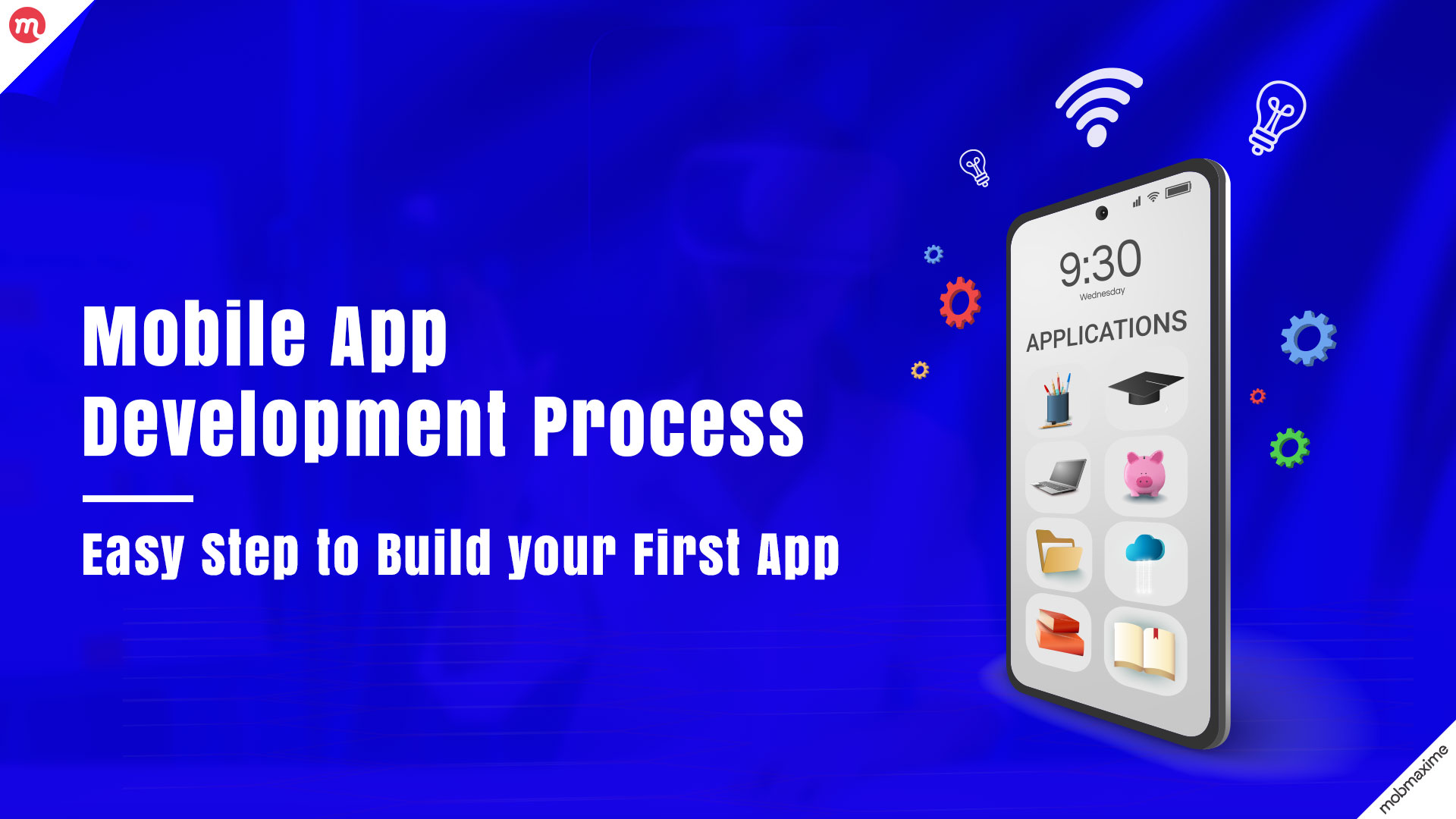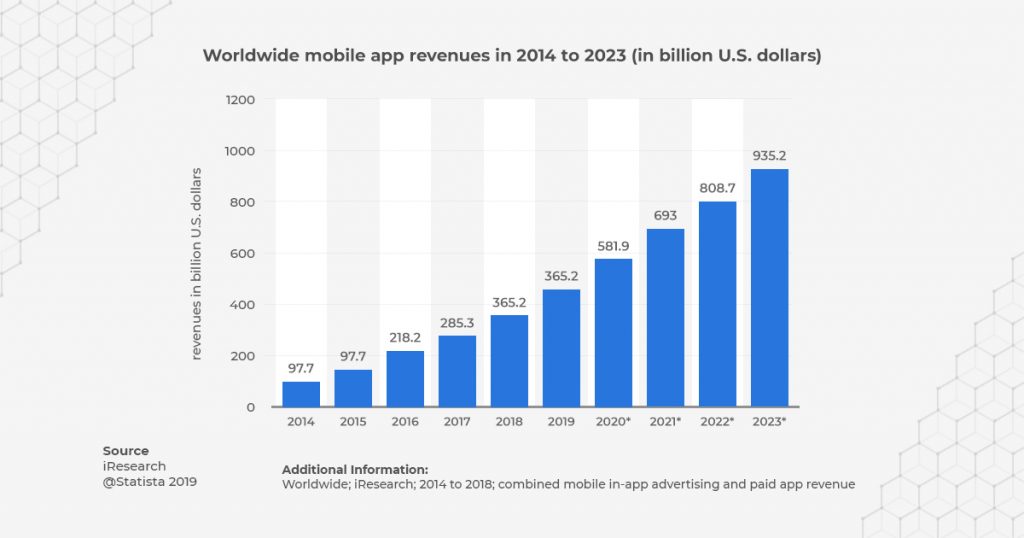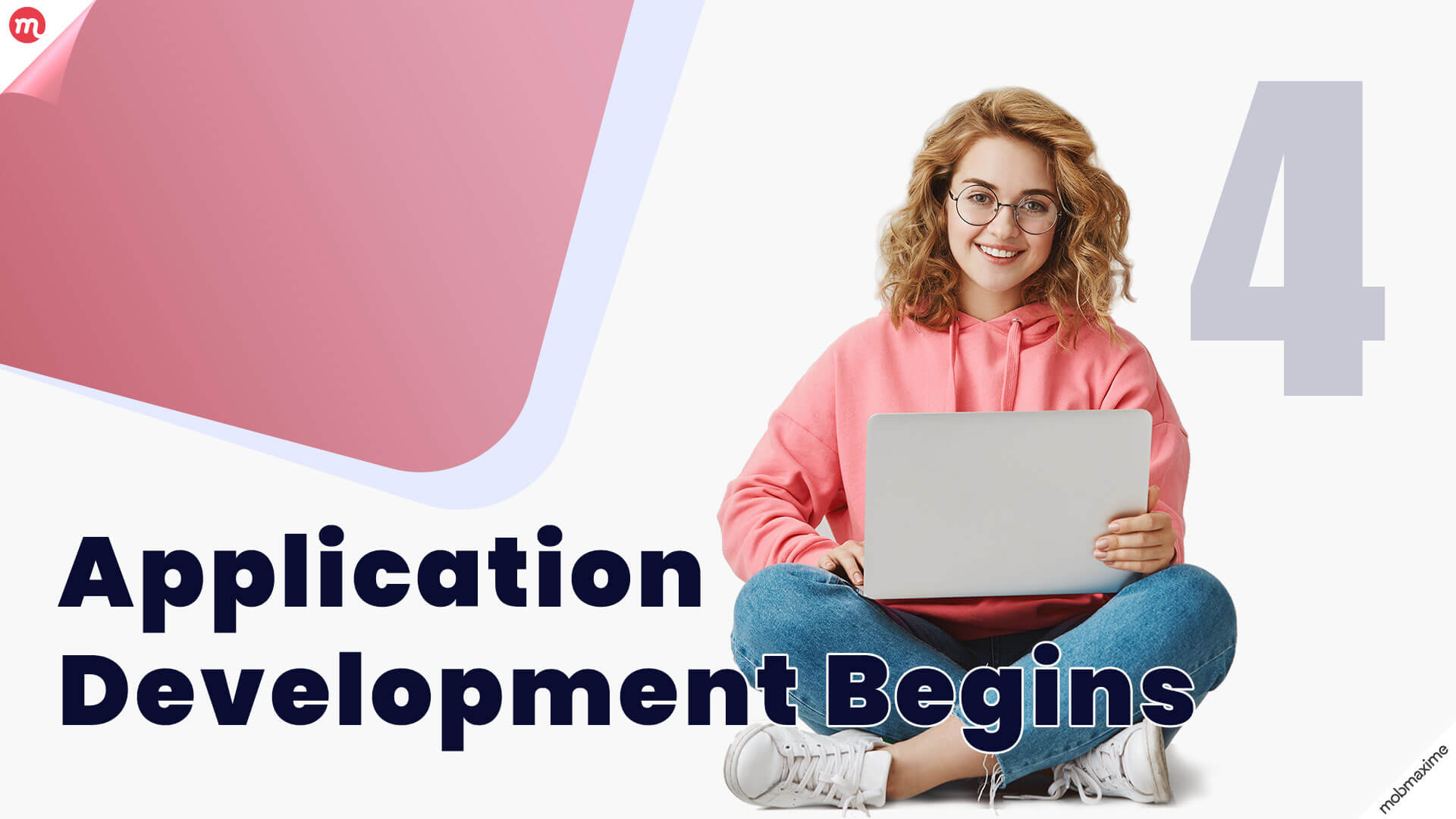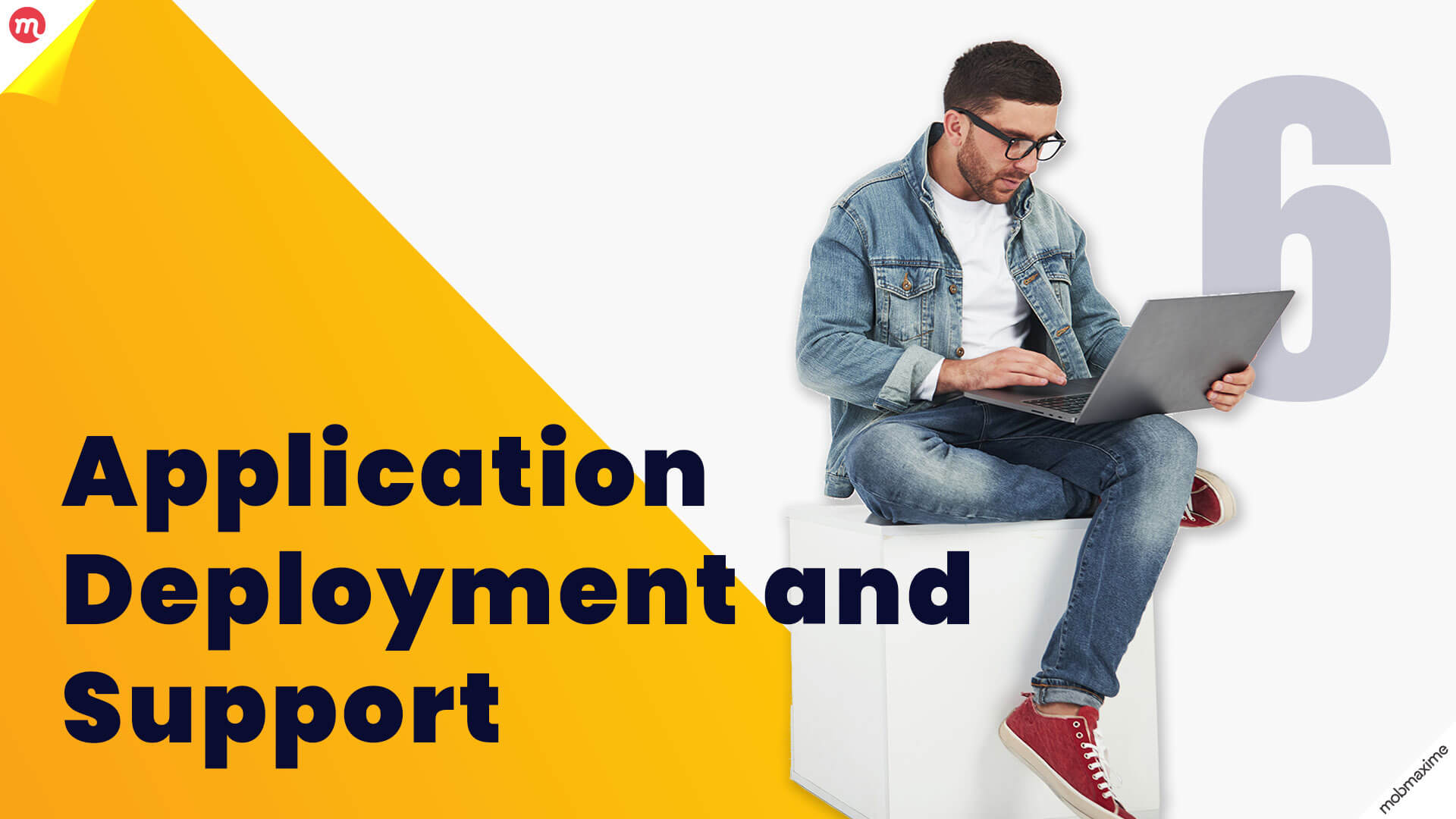Mobile App Development Process: Easy Step to Build your First App

Almost every developer is overwhelmed with “What shall I do?” when they start building their first mobile application. Even after receiving training from the best of the best in the industry, taking this task feels daunting and quite extensive.
Add to this the pressure of creating an application that gets attention in a $510 billion industry. Yes, the enterprise mobility industry is said to cross this mark by 2022. How can an application builder, like yourself navigate the ebbs and flows of a highly competitive industry and succeed at building a mobile application?

Almost everyone in the industry is out here is breaking a sweat to get that one opportunity of getting things right and climbing up the popularity meter. Take it as a disclaimer that the mobile app development process is not an easy bull to tame, but if you do the right things success is not far.
Must Read: The 2021 Oriented Guide to Mobile Application Development Costs
So, let’s move on to understand the process of building a great application, one that has the potential to grow, succeed, and scale on-demand.
Mobile App Development Process Steps
Step 1 – Idea and its Validation
Have you had your light bulb moment? An idea that you think that it will prove to be a useful product for the end-users. If not, formulate, find, or discover an idea for an application that can be converted into a functional product.

Every application is built on solid grounds of one solution that will solve the problem, but take note that the problem must exist to build a solution. So, to get an idea, dip into a universe of problems to find the right idea for your application.
Uber, which was once just an idea to start an on-demand car service, has become a sensation today. The term “Uber” has gained entry into our culture. We have started using uber with reference to other things like an uber for patients, uber for food, and so on.
That is the power of one idea. Almost every phenomenal application or product that we see today was once an idea: PokemonGo, Candy Crush, Instagram, Facebook, even Apple.
The best and most effective way to come up with an idea is by taking the problem-solution route. Find the problem first and then give your solution (idea) to solve that problem.
Every Idea Needs Validation
Once the idea is finalized, it won’t be enough. It is essential to validate it and ascertain whether i will be able to create and market the product. Idea validation needs research.
42% of the startups fail because there is “No Market Need” for these ideas in the market.
That is why validating the idea is essential instead of directly jumping to the development phase.
To validate the idea, a developer needs to conduct extensive market research.
- To determine the idea viability, move forward in the mobile app development process by gathering information. Understand the customers who will get the direct benefit of the generated idea. Look after their needs and identify what influences their buying decisions.
- Check if there are any competitors who offer a similar product. If yes, research their offerings, how they approach the customers, what are the product features, benefits, marketing methods, and everything else.
So, this is how it should go. First, have an idea, then validate it, then find the customers (create buyer personas), and then search for the competitors and know everything about them.
By the end of the first step, the developer shall have a product idea that can be created, promoted, marketed, and generate new demand.
Step 2 – Draft Out a Strategy
Strategy creation follows idea validation. To create a successful product, the developer and the development need to plan out everything that should be done to make it a success.

While idea validation is a part of strategy making, it has been covered in the previous section. The next mobile app development process involves establishing a detailed strategy about marketing, goal setting, objectives, and Feedback incorporation.
Create a roadmap of the objectives and the aspects that must be covered to reach at the apex position. This will help build the MVP or most viable product as having a roadmap helps visualize the objectives followed by working on selecting the core features.
Marketing for a new idea requires developing customer-specific campaigns – this is one of the reasons why identifying the target audience is essential. Followed by this, set the goals and objectives building the application.
Along with this, work on creating a unique value proposition of your application. This is a gimmick or a punchline that anyone can frame by unjumbling some words. But formulating a value proposition has to be done under a set criteria. This includes;
- Clarity: No complex terms or paying lip service.
- Benefits-Oriented: Clearly outline the benefits.
- Unique: What makes the application different?
- Crisp: Easy to understand.
Goals are essential to resonate with the grand scheme of things. Goals and strategy have a symbiotic relationship. Having pre-defined goals helps frame out a strategy and having a strategy makes it easier to achieve those goals.
To help set goals, answer these questions;
- What are the issues that the application will solve?
- What’s the application USP and selling point?
- What will be the core set of features essential for the application?
- What are the prospective benefits the application will offer?
Once the goals are set, and the strategy to promote the app and approach the customers is ready, start thinking about the application design.
Step 3 – Invest in Engaging Designing
Yes, UI/UX designing is a part of the mobile app development process as it helps deliver seamless user experiences. This is a part of setting up Information Architecture, which directly translates to the way an application is organized.

So, while creating the design, it is also important to understand how every feature must engage with the end-user. Creating designs also involves reading the audience’s preferences.
Every application design requires UX researchers and strategists to conduct detailed usability testing. This helps determine what the users like to see, feel, and observe while using an application. It may take some time to complete this kind of usability testing, but if the results generated with this approach are applied to the application designing process, the chances of the application not gaining an honest user base are scant.
Every type of app development process is incomplete without considering UI/UX design. The information architecture or application workflow is created on paper, and it is a fairly easy process that gives the rough structure of the application.
Going deeper into the extent of application development, there are a few other things that must be completed.
- Wireframing: Wireframing is like a digital sketch that helps build a contextual layout of the application. These are also called low-fidelity monochrome mockups that do not have any visually-aesthetic elements, but they do help visualize the structure of the application minus the functional aspects.The designers create the wireframes with the end-user in mind. Not just wireframes, but every aspect of designing is executed with the end-user in mind. The visual representations of a wireframe are essential for building the raw structure of the final application design.
- Styling Guides: These are like printed or digital walk throughs of the application’s design standards and procedures. Also called the ‘living document’ in the designing community, these guides serve a great purpose of helping to decide the font, color, and how it will affect the company’s branding.These guides become even more important in case there are multiple designers working on the same application. Style guides help maintain consistency as the rules and regulations followed herein are applicable to all the designers.
- High-Fidelity Mockups: With the help of style guides, creating high-fidelity mockups is the next step in the mobile app development process. By modifying the wireframes and decorating them with colors, the application starts to get in shape. These kinds of mockups are created with the help of design tools like Sketch, Adobe, etc.The difference between a wireframe and a mockup is that the latter has all the colors, graphics, and illustrations attached, and also, a mockup is the second last step in the application designing exercise, which ends with prototyping.
- Prototyping: Mockups are everything but a complete representation of the application. While mockups are static, prototypes are dynamic. An application’s prototype is created with tools like Figma, and it shows how the application will function without actually codifying everything.It is a great asset for the designers and for the app development process as prototyping allows creating real user-experiences and identifying how every click, swipe, and scroll will react.So, apart from design, prototyping is also a useful aspect that helps determine the functionality of the application without writing even a single line of code.
- Design Handoff: The last step in designing is the handoff, which means that the designers forward all the information about the app design to the developers so that the latter can codify it. Here is yet another benefit of using innovative designing tools like Figma or Mockitt as they help forward the app design dimensions and measurements to the developer with an inbuilt handoff system.Any kind of discrepancies in the handoff will lead to defects in the final application after development is complete. The transition of every aspect of the application from the initial design to a codified product has to be accurate and precise.While creating the design, choosing colors, and adding other elements, the designing tools have predefined codes for every aspect. The same codes need to be used in the coding to create the best and most accurate representation of the application.
Step 4 – Application Development Begins
Yes, this is the part of the mobile app development process where the actual coding process begins. But there are a few prerequisites that must be addressed before coding begins.

First and foremost, decide who is going to build the application. Surely, this is not a task that a developer should do alone. A team is required to cover all the steps successfully and quickly. Because another thing that matters a lot in building an application that becomes popular is time to market.
It may happen that more than one developers are working on the same idea and the application which reaches the market first has an upper hand.
So, make sure to get more people on board to cover the different aspects of the mobile app development process and steps. For developing the application, the development team must include;
- Frontend developers
- Backend developers
- Quality analysts
- DevOps
The next step is identifying the tech stack for the development. The tech stack is the collection of tools that must be used to build the application. Consequently, there are different types of tools required to deliver the work required for frontend, backend, quality analysis, DevOps, designing, etc.
The choice of the tech stack further depends on the platform selection on which the application is supposed to run. Will it be iOS, Android, or both? Because in any case, the tools and mobile app development process will be different.
Without going into too much detail about the type of development process (native or cross-platform), let’s focus on the importance and meaning of backend and frontend development.
- Backend Development: Backend or server-side development includes building the database and other support functions to run the application. Backend developers take care of essential functions that provide a strong infrastructure, speed, and functionality to the application.
- Frontend development: If backend development is about the support structure and functionality, the frontend is about the looks and aesthetics of the application. It is related to how the client-side of the application helps decide how the application looks to the end-user. This is where the mobile app development process of creating engaging user experiences and immersive aspects matter.
- API or Application Programming Interface: API is a great way to build a connection between the backend and frontend. Along with this, it also helps build connections between two different applications. The one-click login feature that is often observed in applications today is a result of API. As a developer, it is important to harness such possibilities and implement the same in the development process.
Working on these aspects will help complete the development process and what’s left now is testing and deployment.
Step 5 – Testing
Every application must pass through five levels of application testing. It is an integral part of the application development process that facilitates quality assurance and ensures that the built application is stable, secure, and easy to use.

The four types of testing integral to the mobile app development process are;
| Testing Type | Importance |
| User Experience Testing | Check for the application consistency in terms of fonts, color palette, padding, navigability, icon, items, among other things in the application.
The potential users of all the applications must get a smooth and seamless experience that ensures high-quality workflow, engagement, and interactivity. |
| Functional Testing | The purpose of Functionality Testing is to ensure that all the users have a similar experience while interacting the same feature.
Functional test is meant to find out that even when two different users interact with the same feature differently, the end result must be the same for both. |
| Performance Testing | Performance testing is all about knowing whether or not the application is able to complete the user requests have a faster and adequate response.
It includes testing things like app screen loading time, is the application draining the battery, what’s the bandwidth used by the application. One way to test the application’s performance is by simulating the maximum number of concurrent users for backend testing. In the end, the application must work smoothly even when the load spikes. |
| Security Testing | Vulnerable applications are the most fearful thing for an enterprise. A lack of security leads to hacks and data theft. Although the quality assurance team is adept in taking care of this aspect, many developers hire outside agencies to take care of the security testing.
Every user session needs to be checked and authenticated. It must be ensured that every session terminates when the user ends the same or even when the system is left idle for a fixed time period. |
Once testing is done, and it is assured that there are no leaks in the framework, performance, and security the application is ready to be deployed.
Step 6 – Application Deployment and Support
The deployment procedure depends on the platform for which the application has been developed. An Android application has to be launched on Play Store, and the one designed for iOS devices will be deployed on App Store.

However, if the same application has been developed with a cross-platform mobile app development process, it can be deployed for both platforms at once. For both platforms, it is essential to have a developer’s account before launching the application.
Conclusion
Building an application is easier said than done. Right from idea generation to deployment and maintenance, everything requires extensive research and planning. More importantly, it is a continuous process that requires an iterative approach. This means that the application must be changed as per the user feedback and the requisite functions must be added or removed.
Hence, it is imperative to follow all the mobile app development process steps sequentially to ensure the best results. Even though the entire process is a bit tedious, it is rewarding provided the developer follows the right process.
Join 10,000 subscribers!
Join Our subscriber’s list and trends, especially on mobile apps development.I hereby agree to receive newsletters from Mobmaxime and acknowledge company's Privacy Policy.
